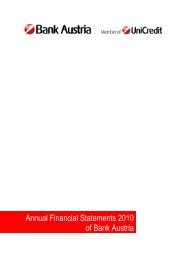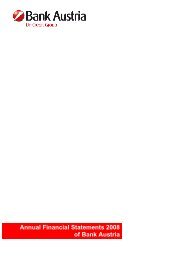Annual Financial Statements 2011 of Bank Austria
Annual Financial Statements 2011 of Bank Austria
Annual Financial Statements 2011 of Bank Austria
Create successful ePaper yourself
Turn your PDF publications into a flip-book with our unique Google optimized e-Paper software.
Management Report<br />
Management Report (CONTINUED)<br />
least not continued deterioration, in asset quality – is well-founded.<br />
However, the decline seen in the past few quarters cannot be<br />
expected to continue at the same pace. In some countries, methodological<br />
factors (IFRS harmonisation, Basel 2 implementation)<br />
also had a non-recurrent favourable effect. Other countries will yet<br />
experience a turn for the better in terms <strong>of</strong> asset quality. But the<br />
favourable effect resulting from the development <strong>of</strong> the provisioning<br />
charge will be sustainable. After the improvement in <strong>2011</strong>,<br />
countries where the cost <strong>of</strong> risk is disproportionately low account<br />
for 72% <strong>of</strong> the CEE loan portolio; if Bulgaria, which is close to the<br />
average, is included in the calculation, the percentage rises to<br />
78%. At the other end, three countries where the cost <strong>of</strong> risk<br />
exceeds 300 bp account for about 15% <strong>of</strong> the loan portfolio but<br />
46% <strong>of</strong> net write-downs <strong>of</strong> loans and provisions for guarantees<br />
and commitments. This means that the provisioning charge concentrates<br />
on a few countries.<br />
net operating pr<strong>of</strong>it (€ 1,472 m) in <strong>2011</strong> was up by € 335 m or<br />
29.5% (adjusted for exchange rate movements, +37.8%) on the<br />
previous year. The balance <strong>of</strong> non-operating items to be deducted<br />
from this figure to obtain pr<strong>of</strong>it before tax was slightly negative<br />
(– € 10 m, after +€ 6 m in 2010). The swing in net non-operating<br />
items is explained by net additions to provisions for risks and<br />
charges (– € 14 m), which were down by € 22 m from the previous<br />
year’s figure. Net income from investments in the CEE Division<br />
was € 6 m, compared with € 46 m in 2010. The decline reflects<br />
various factors: write-downs on the Greek government bonds held<br />
by our banking subsidiary in the Czech Republic and by a subsidiary<br />
<strong>of</strong> the bank in Turkey amounted to € 119 m. This charge<br />
was almost fully <strong>of</strong>fset by other items including the revaluation<br />
gain from the restructuring <strong>of</strong> the Moscow Interbank Currency<br />
Exchange (MICEX) Group, in which our Russian banking subsidiary<br />
holds an equity interest, and gains on the sale <strong>of</strong> administrative<br />
buildings (Czech Republic) and real estate (Turkey).<br />
In <strong>2011</strong>, CEE generated a pr<strong>of</strong>it before tax <strong>of</strong> € 1,462 m; the<br />
figure was 28.0% up on the previous year (at constant exchange<br />
rates, +36.4%). Excluding the write-downs on Greek government<br />
bonds, the year-on-year increase would have amounted to over<br />
38%, also in euro terms. As pr<strong>of</strong>it before tax increased at a rate<br />
that was a multiple <strong>of</strong> the rate <strong>of</strong> change <strong>of</strong> average equity<br />
(+8.2%), return on equity before tax improved by 1.9 percentage<br />
points to 12.3%. Despite the high level <strong>of</strong> equity allocated to<br />
the CEE business segment, its contribution to <strong>Bank</strong> <strong>Austria</strong>’s<br />
overall results for <strong>2011</strong> was both positive and significant in terms<br />
<strong>of</strong> value creation: Economic Value Added (marginal EVA) was<br />
€ 378 m (after € 116 m in the previous year). Risk-adjusted return<br />
on risk-adjusted capital was 5.75%.<br />
Countries and country groups<br />
TUrKEY rUSSIA<br />
CEnTrAL<br />
EUroPE1) SoUTH-<br />
EAST<br />
EUroPE2) EASTErn<br />
EUroPE 3)<br />
<strong>Bank</strong> <strong>Austria</strong> · <strong>Annual</strong> <strong>Financial</strong> <strong>Statements</strong> <strong>2011</strong><br />
CEE<br />
dIvISIon 4)<br />
Average riskweighted<br />
assets (€ bn) 17.4 12.7 17.8 20.6 9.2 81.5<br />
Change on prev. year<br />
in % +13% +21% +5% +9% –9% +8%<br />
Change on prev. year<br />
in % at constant<br />
exchange rates +32% +23% +4% +10% –5% +13%<br />
operating income<br />
(€ m) 1,016 724 913 1,449 447 4,722<br />
Change on prev. year<br />
in % –10% +6% +5% +3% +9% +1%<br />
Change on prev. year<br />
in % at constant<br />
exchange rates +6% +8% +5% +4% +5% +5%<br />
net operating pr<strong>of</strong>it<br />
(€ m) 505 407 275 476 10 1,472<br />
Change on prev. year<br />
+€ 196 m<br />
in % –14% +30% +9% +21%<br />
5) Change on prev. year<br />
in % at constant<br />
+29%<br />
exchange rates +1% +32% +8% +23% +38%<br />
1) Central Europe (CE) = Czech Republic, Slovakia, Hungary and Slovenia. / 2) Bulgaria and Romania;<br />
Croatia, Bosnia and Herzegovina, and Serbia. / 3) Kazakhstan, Ukraine and Baltic countries. /<br />
4) Difference compared with total for banking subsidiaries = CEE headquarters in Vienna. /<br />
5) Swing <strong>of</strong> € 196 m from net operating loss to net operating pr<strong>of</strong>it.<br />
Reports on CEE banking subsidiaries<br />
� Turkey: In <strong>2011</strong>, Turkey maintained solid macroeconomic<br />
fundamentals. Domestic demand continued to be strong, leading<br />
to 8% 2) GDP growth in <strong>2011</strong>, one <strong>of</strong> the highest in the<br />
world. On the inflation front, following historically low singledigit<br />
levels in the first half <strong>of</strong> the year, inflation increased in the<br />
last few months and reached 10.4% as <strong>of</strong> the end <strong>of</strong> <strong>2011</strong>,<br />
impacted by currency depreciation as well as increased prices<br />
and taxes on certain consumption goods. Throughout <strong>2011</strong>, the<br />
Central <strong>Bank</strong> <strong>of</strong> Turkey adopted an unconventional monetary<br />
policy which varied significantly from quarter to quarter to<br />
manage the current account deficit, inflation, currency depreciation<br />
and growth. As <strong>of</strong> the end <strong>of</strong> <strong>2011</strong>, the policy rate was<br />
maintained at its low level <strong>of</strong> 5.75%.<br />
Koç <strong>Financial</strong> Services (KFS), the financial holding company<br />
controlling 81.8% <strong>of</strong> Yapı Kredi, achieved healthy growth and<br />
sustained pr<strong>of</strong>itability in <strong>2011</strong> through proactive management<br />
in a changing and complex operating environment. In <strong>2011</strong>,<br />
KFS recorded 1,960 million Turkish lira (TL) consolidated net<br />
pr<strong>of</strong>it (after minority interests) (8% y/y), reflecting a continued<br />
focus on customer business, healthy core revenue growth, dis-<br />
2) Yapı Kredi Economic Research estimate<br />
40
















